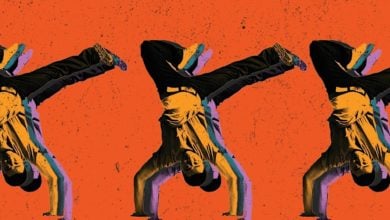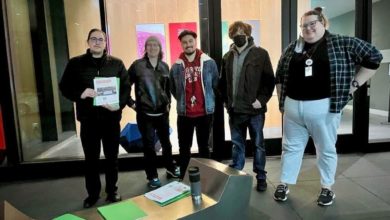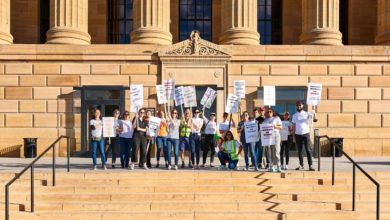Almost one year ago, Ken Loach’s film “The Wind That Shakes the Barley” won the Palme d’Or at the 2006 Cannes Film Festival. Despite winning the top prize at the world’s most prestigious film festival, the film has struggled to get a showing.
In Britain, the film faced a vitriolic attack by the corporate media, due mainly to its subject matter—the Irish war of
 |
A year later, the film is finally being shown in the United States, but it is only in 38 theatres nationwide. The problem here is less about the film’s politics. It is the difficulty of getting distribution faced by any film not made by the U.S. corporate film industry.
Ken Loach is an anti-imperialist filmmaker from Britain who considers himself a socialist. Loach has chronicled the struggles of the working class and the oppressed for more than 40 years.
In his films, he has portrayed the mundane struggles of working class individuals ranging from a mother whose children are taken away by social services to youth facing poverty, crime and a lack of opportunity. He has also made films of historical struggles. “The Wind that Shakes the Barley” is one of those.
Loach noted when collecting the Palme d’Or at Cannes; “Maybe if we tell the truth about the past, we tell the truth about the present.”
The truth “The Wind that Shakes the Barley” tells is about occupation and the intertwining of the national and class struggles in an effort to throw off imperialism. Its specific analysis is about Britain’s colonial occupation of Ireland and the indigenous Irish independence struggle.
As with all of Loach films, it is relentless in telling the story with all its contradictions and human frailties.
The film depicts the different forces in the Irish struggle and their debates about what is to be done.
The main character in the film quotes his recently dead comrade: “It is easy to know what you are fighting against, but it is an honor to know what you are fighting for.”
It is not necessary to have knowledge of Irish history to enjoy and learn from this moving and visually captivating film, but some history of Ireland helps put the film into perspective.
Ireland and British colonialism
Ireland is the world’s oldest continuous colony. Resistance by the Irish against British intervention has been the status quo for 800 years.
The coming of Anglo-Norman mercenaries in 1169 marked the beginning of direct English involvement in Ireland. At the time, the Irish social system was still that of the clan; the importation of feudalism was hotly resisted.
Just when a sort of feudalism was more or less stabilized in Ireland, England experienced a time of enormous and fertile social ferment, with capitalism breaking through the shackles of the old feudal property relations. Karl Marx said, “capital comes dripping from head to foot, from every pore, with blood and dirt.” Much of the blood heralding the emergence of English capital was Irish.
Regardless of the ruler, state or social system of England, the intervention in Ireland continued.
Ireland was utilized for plunder, raw materials and forced conscription. With the advent of early capitalist social relations, new English property laws were imposed on Ireland by barbarous force.
The emergence of full-fleged capitalism in England resulted in the confiscation of Irish-held land, the Protestant settlement of the northern counties of Ireland in the 17th and 18th centuries, the infamous Penal Laws that denied the Irish almost all basic rights including their language, the establishment of a permanent garrison and several brutal invasions.
In the 19th century, the British oficially made it a crime to speak Gaelic, the Irish language. The British landlord system in Ireland produced crops and animals for export, resulting in two devastating famines.
In the election of December 1918, Sinn Fein—the political party representing the aspirations of an independent Irish state—won 73 out of 105 seats. The Irish parliament (Dail Eireann) was established in January 1919.
The popularity of the cause of Republicanism was fueled by the Easter Rising of 1916.
The rising was a failed attempt to gain independence for Ireland by force. It was organized by the Irish Republican
|
Even though, at the time of the Easter Rising, support for their struggle was small, the execution of the leaders and the outlawing of the Dail by the British led to a swing in support of the rebels and Republicanism.
The Irish Volunteers became the Irish Republican Army (IRA). They began a guerrilla war for independence against the British occupation.
Britain responded by calling for volunteers to go to Ireland to reinforce its colonial police force, the Royal Irish Constabulary (RIC). The RIC Reserve Force was recruited and deployed so hastily that there were not enough regular uniforms to go around. Its soldiers wore tan trousers and dark jackets and became known as the “Black and Tans.”
The repressive force was made up largely of returned WWI soldiers in need of jobs. The Black and Tans quickly established a reputation for extreme brutality.
Historical subject relates to current events
“The Wind that Shakes the Barley” is set in Ireland in 1920 during the Irish war for independence.
The film opens with young men in County Cork playing a game of hurling. On their return home, the men are harassed by Black and Tans for their “unlawful assembly.” One young man is beaten to death for refusing to say his name in English.
Damien O’Donovan (Cillian Murphy), a young doctor on his way to an internship in London, is moved to action by the naked brutality of the occupying forces.
Damien joins his brother Teddy (Padraic Delaney) in the IRA. Their unit is a ragtag “flying column” of farmers and boys who train with hurling sticks. They raid a RIC barracks and ambush British soldiers in a pool hall to get arms. When they’re caught, Teddy is tortured in an excruciating scene that conjures up images of Abu Ghraib.
The brutality of the colonial forces reminds the viewer of current events.
Loach and the writer, Paul Laverty, chose to make the film now because of the historical parallels between Ireland and the situation in occupied Iraq.
Damien is forced to kill a young man he has known since childhood because he divulges information that leads to three IRA comrades being killed and Teddy’s torture. The realities of war are unflinchingly portrayed.
References in the film to Britain’s other colonies in India, Africa and the Middle East connect the war in Ireland to other struggles that will erupt in the future as well as the ever present reality of the world today.
Two other main characters in the movie are Sinead (Orla Fitzgerald) and Dan (Liam Cunningham). Both represent important aspects of the war for independence. Sinead embodies the important role women played, and Dan had been in the Irish Citizen Army as a follower of the socialist James Connolly.
In the interest of authenticity, Loach chose actors that are not only Irish but from Cork where the story takes place. The acting throughout is heartbreakingly real and emotionally compelling. The use of the forbidding, yet lush landscape around Cork adds dimension to this harsh story with major consequences for the main characters.
Question of class character
The real contradictions that existed within the Irish struggle become apparent in the film when a Republican court female judge finds for an old woman who owes a property owner. The property owner, who is charging her 500 percent interest, is told he must pay her back.
Teddy, who has become a politician over the course of the film, overturns the decision because the property owner
|
When the December 1921 peace treaty with Britain is signed, the brothers find themselves pitted against one another.
Teddy supports the treaty and the formation of the Irish Free State. He argues that the British are threatening “immediate and terrible war” and urges support for peace by accepting the treaty.
To Damien, Sinead and Dan, peace is also enticing, but they oppose a treaty that makes Ireland a dominion of the British Empire and stipulates that members of the Irish parliament must take an oath of allegiance to the British king. For them, it is not what the Irish people fought and died for.
As with many other imperialist agreements to come, the treaty also calls for partition. Six counties in the North will remain part of England.
Loach portrays the different class interests inherent in the struggle for national liberation in a scene depicting a debate on the treaty.
Dan paraphrases Connolly when he states: “If you remove the English army tomorrow and hoist the green flag over Dublin Castle, all you have done is change the accents of the powerful and the color of the flag.”
Dan, Damien and many of their IRA comrades favor the creation of a workers’ republic in Ireland, not one ruled by the national bourgeoisie.
The scene is compelling and forces the viewer to become engaged with the concrete realities of the period. The British occupation left mass starvation, disease and displacement in its wake.
Loach described these issues in a March 15 interview with Toronto’s Eye Weekly: “Every time a colony wants independence, the questions on the agenda are: a) how do you get the imperialists out, and b) what kind of society do you build? There are usually the bourgeois nationalists who say, ‘Let’s just change the flag and keep everything as it was.’ Then there are the revolutionaries who say, ‘Let’s change the property laws.’ It’s always a critical moment.”
These differences result in a civil war that lasted from 1922-23. The beginnings of this war are shown by Loach.
In the film, as the British army marches out, the new Free State army is shown marching in. The Free State soldiers turn on their former comrades in the IRA who refuse to lay down their arms. The Republicans mete out their own violence against the army of the Free State, but in the end they are defeated.
Though defeated, there is a legacy to their struggle and history has preserved it.
Lenin said of the Easter Rising: “Capitalism is not so harmoniously built that the various sources of the rebellion can immediately merge of their own accord, without reverses and defeats. On the other hand, the very fact that revolts do break out at different times, in different places, and are of different kinds, guarantees wide scope and depth to the general movement, but it is only in premature, individual, sporadic and therefore unsuccessful, revolutionary movements that the masses gain experience, acquire knowledge, and get to know their real leader, the socialist proletarians, and in this way prepare for the general onslaught.”
Loach’s film is made with this revolutionary spirit clearly in mind. It provides a rare and refreshing materialist analysis of a struggle that retains relevance to workers in Ireland and elsewhere today. For revolutionaries and progressives, “The Wind that Shakes the Barley” is essential viewing.







